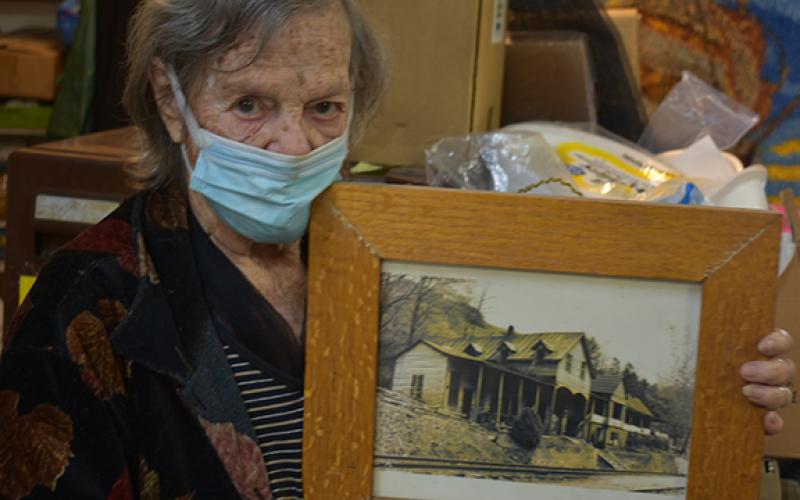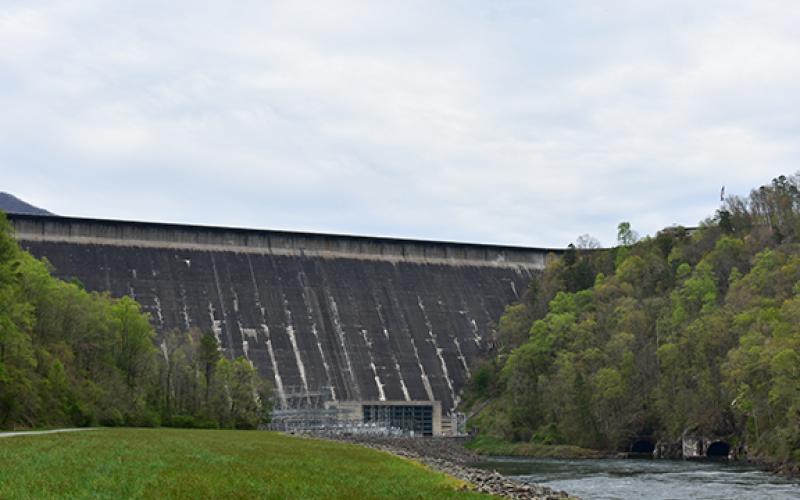Editor’s Note: Austin Campbell is a sophomore at UNCA and served in the Air Force before college. He writes for the UNCA Blue Banner. He is a mass communications major with a minor in German. His hometown is Asheville.
Austin Campbell
Special to Smoky Mountain Times
In the 1940s, some Western North Carolinian residents were offered a false choice: accept a small amount of money for your family’s home place, lose your property or don’t take the money and the Tennessee Valley Authority still takes your land.
At the bottom of this lake surrounded by mountains lies almost forgotten communities. Tennessee Valley Authority flooded several Swain County communities to form Fontana Lake to power Fontana Dam. For many, this is a story of the past, a lost world forever gone, but for others the sting is ever present.
There are still those who remember a time before their family’s rugged land was stripped from them.
In an outdoor sports shop in downtown Bryson City, a woman wearing a leaf-patterned jacket sits asleep in a plastic lawn chair. Juanita Lester, the 89-year-old shop owner, is one of the few people left who was born in one of the now waterlogged towns. Lester was born in Bushnell, a town larger than many in the region in its day. The town had a feed store, grocery store and train station, which the people of Bushnell simply called the depot.
Lester’s grandfather worked on the narrow-gauge railroad system, while her father was a preacher. She reminisces fondly about her birthplace, recalling her Appalachian childhood.
“My grandfather had a nice house,” she said. “He had several houses he let people live in, if they could afford it or not. Every house was built by hand. My family had a little spring house up on the hill and the best water you'd have ever seen. The water would run down to the house to a little built trough, and where we got our water from. I remember playing around in the water trough.”
Lester said some of her family members got all of their water from the spring house and didn’t have running water inside their homes.
“I had a wonderful life living in Bushnell,” she said. “My grandmother helped mother take care of us. It was just great. We had a wonderful life there.”
Even though Lester was relatively young before the flooding of Bushnell, she vividly remembers when the government employee came to purchase her grandfather’s 200-acre property and inform them they had to leave.
“The day that my grandfather took the check from the government official to pay for his land, he took the check and handed it to my grandmother. My grandmother cried. I was just a little thing, but I wanted to run up to the man with the check and tear it all to pieces and tell him ‘there. Now it's no good,’” she remembers.
“I was too young to remember the year, but I was young enough to know that I hated that man,” she said with sharp anger to her voice.
The impact of these memories has stuck with her for her entire life. After all these decades, she said, there’s still anger for her.
“I've never been particularly happy about the dam being built. The government never gave the people nothing,” she said. “They kicked people out, with hardly enough time to even grab what they owned. If the people around here had any brains, they would feel the same way I do about the Tennessee Valley Authority.”
In 1943 and 1944, the Tennessee Valley Authority attempted to buy out the remaining families on the North Shore. Many families refused to be removed further from their newly established homes, but in the end there were all forced to move. The lake also submerged the only remaining road that could take them to the north shore. The land these people were forced from is now a part of the Great Smoky Mountains National Park.
The federal government promised the families removed from their homes on the North Shore the construction of a new road to continue to have access to their ancestral graveyards. Unfortunately, the road was only partially built by the Department of the Interior and remains incomplete. The 7-mile route, aptly referred to as the ‘Road to Nowhere,’ concludes at a tunnel in the Smokies, and some of the cemeteries remain inaccessible to the older people who the graves mean the most. For some in Swain County, the incomplete road represents another lie after the many they had already heard.
Not only were larger towns of the time affected by the lake’s cold water and the federal government’s chilling actions but smaller homesteads such as Kirkland Branch also plunged under the lake’s depths.
Earl Kirkland is 68 years old. His dad was born in 1930 and was raised in Kirkland Branch. As an immediate descendant, Kirkland heard in detail what Kirkland Branch was like.
“My dad was raised on Kirkland Branch down there by Chambers Creek. These places were taken for the dam. Kirkland Branch was just a homestead,” he said. “There was an apple orchard where people lived and had farms. They grew everything to eat. During this time, a lot of the people around here did logging, but some of them worked on the railroads.”
According to Kirkland, even though many people lived in the valley area, most were separated by their hollers and didn’t form together against the dam’s construction.
“A lot of those folks lived off the land, or logging or the railroad, I guess. But most people lived down on the farms in the low-country at that time. When they moved these people out, they got moved out to places like Marion or Asheville. Not all of them settled back in Swain County,” Kirkland said.
“A lot of them had to move to where the work was at. Some of the people got paid for their property, and some others didn’t. Some just got paid enough to cover the taxes on what they had,” he added. “A lot of people got paid less than 50 cents an acre. It wasn’t right, but that was the way things were back then.”
Several families felt forced out of the region for one reason or another, such as those who followed the lumber industry out West, but some stayed close to their roots. Regardless of the circumstances, Kirkland said there were a lot of hurt feelings during that time frame.
“Whenever they built the dam, they told a lot of people that they could come back to visit their homes, but when these people would come back, they would find that the Tennessee Valley Authority had burnt their house down,” Kirkland said. “Both the National Park and TVA did people wrong. I think a lot of the people living back then are better off than we are today,” he said with an ironic laugh.


